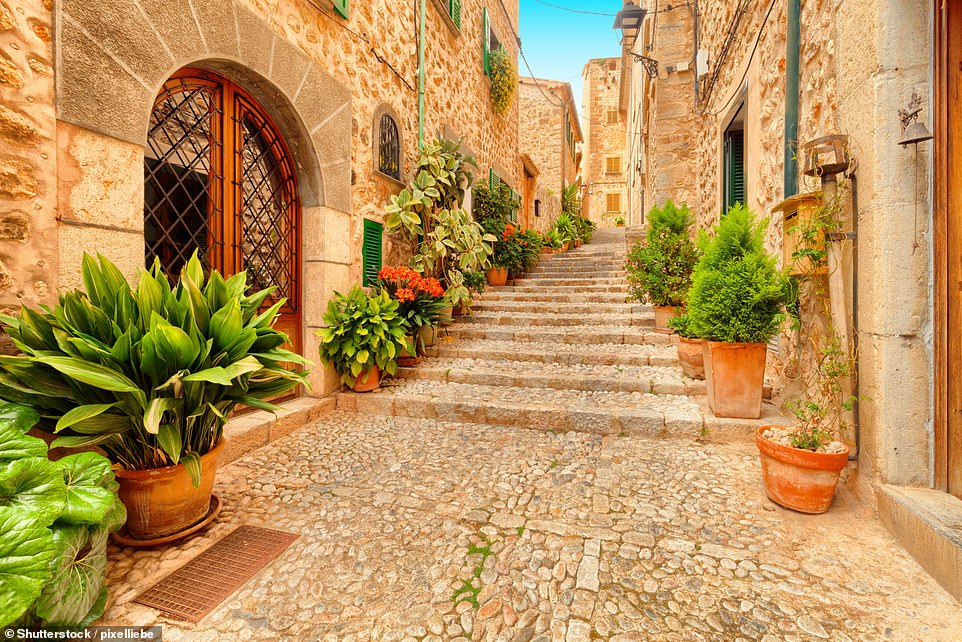Long sandy beaches, bustling resorts, bucket-and-spade family holidays – this is how most people think of Majorca, the largest of the Balearic Islands, beloved of Britons since it first welcomed tourists in the 1950s.
Yet away from the cluttered developments, there is a different island to discover – from the forested peaks of the Tramuntana mountains to the central plains and the lesser-known north-east coast, there are perfect villages and towns to discover where life goes on much as it always has.
Many of the prettiest villages are found in the Tramuntana, the jagged backbone of Majorca, a dramatic mountain range stretching for 55 miles from Andratx in the south to Cap Formentor in the north. The best way to explore is by car – particularly if you want to reach some of the most remote villages – and although roads can be small and winding, they’re generally in good condition.

Bay of plenty: Majorca has perfect villages and towns to discover where life goes on much as it always has. Pictured is Port de Soller
Most visitors make straight for Deia, arguably the most beautiful village. Whichever way you approach, either along the vertiginous coastal road from Soller or north from Valldemossa, the first glimpse is unforgettable – a cluster of auburn-hued houses and terracotta roofs clinging to the mountainside, dotted with cypress trees and palms.
Beloved of writers and artists since the poet Robert Graves lived in the village from 1929 until his death in 1985, the streets are filled with art galleries, cafes and some of the island’s best restaurants. Reserve a table on the terrace at Es Raco d’es Teix (esracodesteix.es) for wonderful views.
Further south and much less well known, sleepy Banyalbufar is one of the last remaining undeveloped coastal villages on Majorca. The views are the big draw here, with ancient terraces stepping down towards the sea.

Unforgettable: The poet Robert Graves lived in the village of Deia from 1929 until his death in 1985
Take some time to drink in the views and a glass of local Malvasia wine at the San Tomas restaurant, or stay a night or two at Son Borguny (sonborguny.com) – a 15th Century townhouse.
If you’re not keen on mountain roads, the good news is that some of the island’s most charming villages are accessible on foot.
Leave the car in the leafy town of Soller and follow the ancient path up to Fornalutx. The seven-mile walk takes in the hamlet of Binibassi and gives spectacular views of the Puig Major – Majorca’s highest peak.
Fornalutx, with shady, cobbled streets that date back more than 1,000 years, has been voted the prettiest village in Spain. Pottering around the flower-dotted alleys is a lovely way to spend an hour or two, and there are several places to stop for a leisurely lunch.
Es Turo has wonderful mountain views from the terrace and serves up classic Spanish dishes – the seafood fideua (similar to paella but made with noodles instead of rice) is legendary (esturo.com). If you want to stay a night or two, Can Reus (canreusmallorca.com) is an enchanting boutique hotel.

An aerial view of the Tramuntana mountains near Banyalbufar, one of the last remaining undeveloped coastal villages on Majorca
From Fornalutx, follow a different route back to Soller on foot, taking in the smaller and quieter village of Biniaraix.
From the centre of the village, waymarked trails stretch out across the wooded hills, and the tables outside Bar Bodega are often busy with hikers and rock-climbers, filling up on pa amb oli (a classic dish of bread smothered in garlic and tomatoes).
If driving on mountain roads doesn’t faze you, follow the winding lane from Alaro to Orient, one of the island’s most remote villages. Although it has a population of just 30, in the summer months and at weekends it buzzes with walkers and Palma residents who flock to the trio of restaurants that serve some wonderful local dishes.

Pottering around the flower-dotted alleys of Fornalutx is a lovely way to spend an hour or two, writes Annabelle

Fideua is a classic Spanish dish similar to paella but made with noodles instead of rice
Stay a night or two at the Finca Hotel Son Palou (sonpalou.com), which has 15 elegant bedrooms, and tuck into beautifully presented dishes in its cosy restaurant.
In the far north of the Tramuntana, many visitors miss the inland town of Pollenca. A long-time hub for artists and writers, drawn to the beauty of the area, the town has a sophisticated atmosphere and an impressive square fringed with cafes and restaurants. Bag a table at Q11 (q11restaurant.com), which is renowned for its refined tapas and wine list.
Capdepera, on the north-east coast, is an under-the-radar gem. A clutch of saffron-coloured houses and alleys are dominated by a spectacular 14th Century fortress said to have been built by King Jaime II at the time of pirate attacks.
Visit on a Wednesday when the market is in town, selling everything from food to patterned ceramics, jewellery and clothes.
Stop for lunch at La Fragua (lafragua.es) and book a romantic night at Cases de Son Barbassa, a hotel overlooking the sea, just outside the village (sonbarbassa.com).
Source link : https://www.dailymail.co.uk/travel/escape/article-9752417/Green-list-travel-Discover-Majorcas-perfect-village-towns-away-crowded-resorts.html












